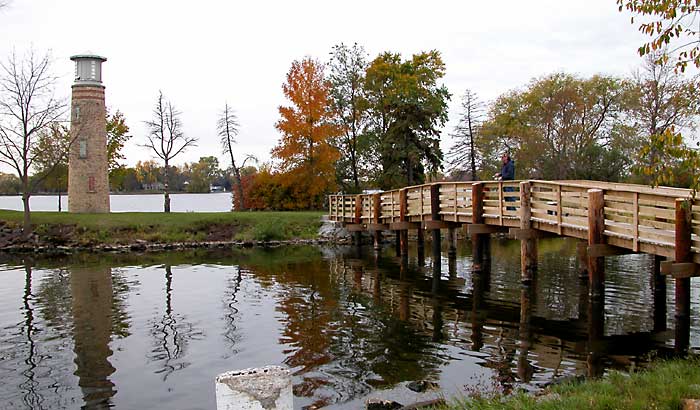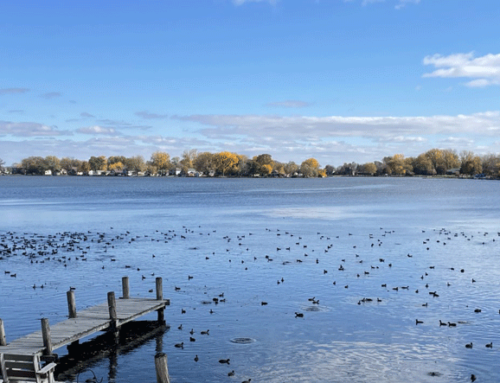Do you ever wonder how a particular land mark came to be? Vicky Redlin from the Winnebago County Parks Department put together a brief history about boat landings and related land marks in Winnebago County. We found her documents to be quite interesting, so we decided to share the history in a six part series. The first in the series is about Asylum Point Park and Lighthouse.
Asylum Point Park
On the central western shore of Lake Winnebago, just a few miles north of Oshkosh, a promontory extends into the water. On this point in 1871, construction began on the Northern Asylum for the Insane. The name of the institute was later changed to Winnebago Mental Health Institute, reflecting perhaps an increasingly sensitive public, but the hospital’s original name has been forever connected with the surrounding geography. The promontory is still known as Asylum Point, and the surrounding water is called Asylum Bay.
The word Asylum means a place of refuge or sanctuary, and the institute “has throughout its history, provided many troubled individuals with a sanctuary, a refuge, and a safe place to prepare for re-entry into a turbulent world.” The same statement of purpose might just as well be applied to the nearby Asylum Point Park, as many people come to the park to take refuge from a turbulent world and spend a carefree afternoon fishing in the tranquil waters or simply relaxing on the man-made island next to the Asylum Point Lighthouse.
Asylum Bay Lighthouse
The lighthouse stands sentinel in a once busy area known as Asylum Point Park that separates North and South Asylum Bay. It was formerly known as Lighthouse Island and Picnic Point. WCC and WPS were involved with this area’s development in the 1930’s and 40’s and reportedly constructed the lighthouse in 1937 on an artificial island (though it was rejected by the Department of Transportation as a navigational light for the lake and was thus never lit). The main tower is over 24 feet tall, 8 ft around at the base, and tapers to 6 ft around at the top. The copper topped 7 foot tall cupola was formerly topped by a flag pole to make the entire height 42 feet. In 2007, the lighthouse received a $4,000 makeover with labor provided by inmates from the Winnebago Correctional Institute. Parts of the wooden lantern room were replaced, windows were refitted, and the metal roof was rebuilt. Reconstruction replaced the flag pole with a copper fish weather-vane.
known as Lighthouse Island and Picnic Point. WCC and WPS were involved with this area’s development in the 1930’s and 40’s and reportedly constructed the lighthouse in 1937 on an artificial island (though it was rejected by the Department of Transportation as a navigational light for the lake and was thus never lit). The main tower is over 24 feet tall, 8 ft around at the base, and tapers to 6 ft around at the top. The copper topped 7 foot tall cupola was formerly topped by a flag pole to make the entire height 42 feet. In 2007, the lighthouse received a $4,000 makeover with labor provided by inmates from the Winnebago Correctional Institute. Parts of the wooden lantern room were replaced, windows were refitted, and the metal roof was rebuilt. Reconstruction replaced the flag pole with a copper fish weather-vane.
Originally the island was made by filling in marsh to make an island of 600’ x 75’. The island had open air fireplaces, trees, shrubs, flowers, and was popular with picnickers who gained access by a wooden bridge. Later a fishpond holding area was created by dredging of the channel for a rough fish removal program run by the WDNR. The WDNR still maintains a fish station at this location. It was also used as a beacon for those on the lake in bad weather. About 1 million pounds of Carp were caught by local fishermen and sold to markets in Chicago and NY annually through this fish processing operation. The lighthouse served as a beacon for those bringing in their catch to the operation’s headquarters. Lit by kerosene lantern the light could be seen 12 miles out on a clear night. The area once boasted barges, boat building, and fish trapping equipment. During restoration an attempt was made to illuminate the lighthouse with solar or electrical fixtures but the plan was abandoned because of TSA concerns.
Author: Vicky Redlin, Winnebago County. Article was republished with permission.
Read more: https://www.co.winnebago.wi.us/sites/default/files/uploaded-files/asylum_point.pdf
Winnebago Waterways is a Fox-Wolf Watershed Alliance program. The Fox-Wolf Watershed Alliance is an independent nonprofit organization that identifies and advocates effective policies and actions that protect, restore, and sustain water resources in the Fox-Wolf River Basin.
Follow the Fox Wolf Watershed Alliance’s Winnebago Waterways Program on our Winnebago Waterways Facebook page or @WinnWaterways on Twitter! You can also sign-up for email updates at WinnebagoWaterways.org.
Questions or comments? Contact Korin at korin@fwwa.org or (920) 920-851-0948.






